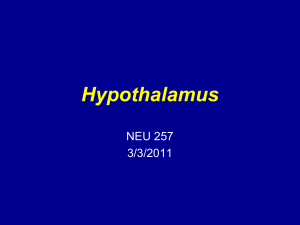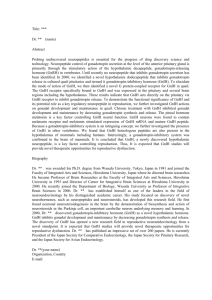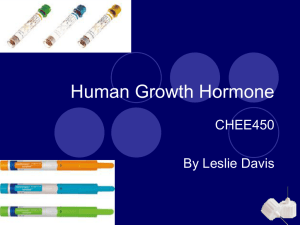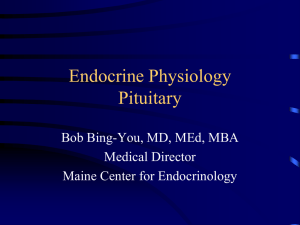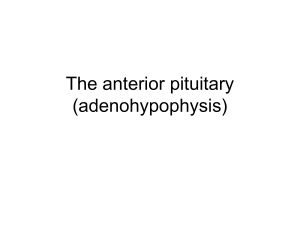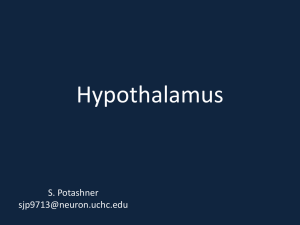FIGURE LEGENDS FIGURE 38.1 Overview of the central
advertisement
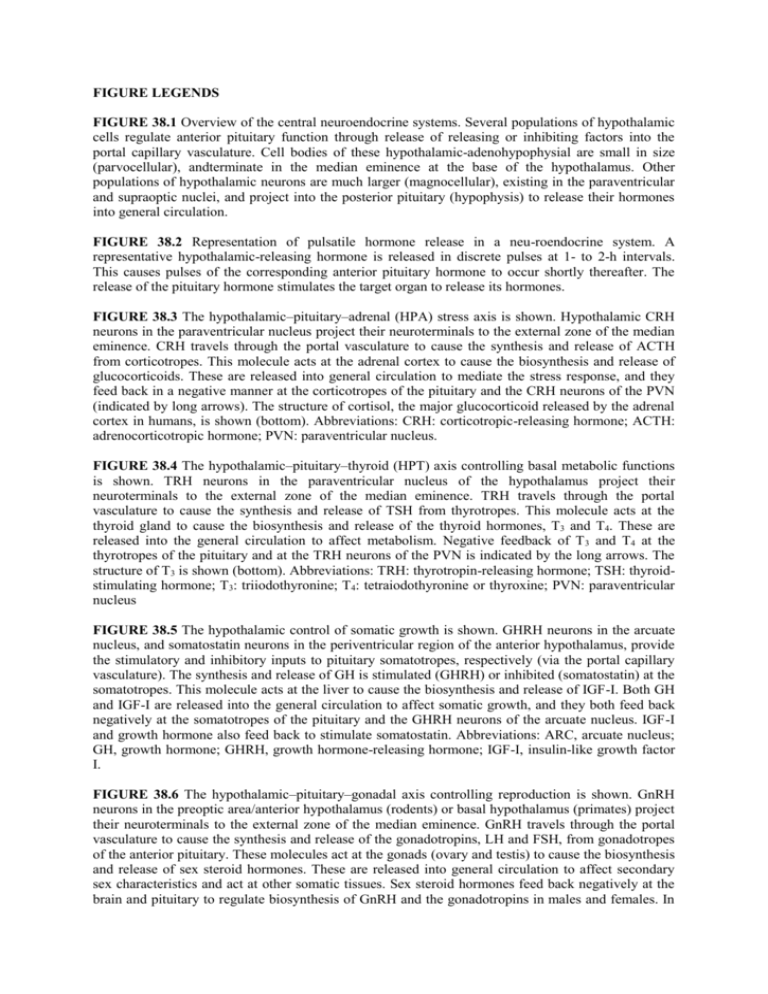
FIGURE LEGENDS FIGURE 38.1 Overview of the central neuroendocrine systems. Several populations of hypothalamic cells regulate anterior pituitary function through release of releasing or inhibiting factors into the portal capillary vasculature. Cell bodies of these hypothalamic-adenohypophysial are small in size (parvocellular), andterminate in the median eminence at the base of the hypothalamus. Other populations of hypothalamic neurons are much larger (magnocellular), existing in the paraventricular and supraoptic nuclei, and project into the posterior pituitary (hypophysis) to release their hormones into general circulation. FIGURE 38.2 Representation of pulsatile hormone release in a neu-roendocrine system. A representative hypothalamic-releasing hormone is released in discrete pulses at 1- to 2-h intervals. This causes pulses of the corresponding anterior pituitary hormone to occur shortly thereafter. The release of the pituitary hormone stimulates the target organ to release its hormones. FIGURE 38.3 The hypothalamic–pituitary–adrenal (HPA) stress axis is shown. Hypothalamic CRH neurons in the paraventricular nucleus project their neuroterminals to the external zone of the median eminence. CRH travels through the portal vasculature to cause the synthesis and release of ACTH from corticotropes. This molecule acts at the adrenal cortex to cause the biosynthesis and release of glucocorticoids. These are released into general circulation to mediate the stress response, and they feed back in a negative manner at the corticotropes of the pituitary and the CRH neurons of the PVN (indicated by long arrows). The structure of cortisol, the major glucocorticoid released by the adrenal cortex in humans, is shown (bottom). Abbreviations: CRH: corticotropic-releasing hormone; ACTH: adrenocorticotropic hormone; PVN: paraventricular nucleus. FIGURE 38.4 The hypothalamic–pituitary–thyroid (HPT) axis controlling basal metabolic functions is shown. TRH neurons in the paraventricular nucleus of the hypothalamus project their neuroterminals to the external zone of the median eminence. TRH travels through the portal vasculature to cause the synthesis and release of TSH from thyrotropes. This molecule acts at the thyroid gland to cause the biosynthesis and release of the thyroid hormones, T3 and T4. These are released into the general circulation to affect metabolism. Negative feedback of T 3 and T4 at the thyrotropes of the pituitary and at the TRH neurons of the PVN is indicated by the long arrows. The structure of T3 is shown (bottom). Abbreviations: TRH: thyrotropin-releasing hormone; TSH: thyroidstimulating hormone; T3: triiodothyronine; T4: tetraiodothyronine or thyroxine; PVN: paraventricular nucleus FIGURE 38.5 The hypothalamic control of somatic growth is shown. GHRH neurons in the arcuate nucleus, and somatostatin neurons in the periventricular region of the anterior hypothalamus, provide the stimulatory and inhibitory inputs to pituitary somatotropes, respectively (via the portal capillary vasculature). The synthesis and release of GH is stimulated (GHRH) or inhibited (somatostatin) at the somatotropes. This molecule acts at the liver to cause the biosynthesis and release of IGF-I. Both GH and IGF-I are released into the general circulation to affect somatic growth, and they both feed back negatively at the somatotropes of the pituitary and the GHRH neurons of the arcuate nucleus. IGF-I and growth hormone also feed back to stimulate somatostatin. Abbreviations: ARC, arcuate nucleus; GH, growth hormone; GHRH, growth hormone-releasing hormone; IGF-I, insulin-like growth factor I. FIGURE 38.6 The hypothalamic–pituitary–gonadal axis controlling reproduction is shown. GnRH neurons in the preoptic area/anterior hypothalamus (rodents) or basal hypothalamus (primates) project their neuroterminals to the external zone of the median eminence. GnRH travels through the portal vasculature to cause the synthesis and release of the gonadotropins, LH and FSH, from gonadotropes of the anterior pituitary. These molecules act at the gonads (ovary and testis) to cause the biosynthesis and release of sex steroid hormones. These are released into general circulation to affect secondary sex characteristics and act at other somatic tissues. Sex steroid hormones feed back negatively at the brain and pituitary to regulate biosynthesis of GnRH and the gonadotropins in males and females. In addition, prior to ovulation, these steroids exert positive feedback in females. The structure of estradiol is shown (bottom). Abbreviations: FSH, follicle-stimulating hormone; GnRH, gonadotropinreleasing hormone; LH, luteinizing hormone; MBH, medial basal hypothalamus. FIGURE 38.7 The hypothalamic control of lactation is depicted. Hypothalamic cells in the arcuate nucleus release dopamine into the portal capillary vasculature. The dopamine exerts negative regulation of prolactin release under most circumstances, via inhibitory D2 receptors. During lactation this inhibition is relieved and prolactin is released from the lactotropes of the anterior pituitary gland. Abbreviations: ARC, arcuate nucleus; DA, dopamine; PRL, prolactin. FIGURE 38.8 The hypothalamic-neurohypophysial control of vasopressin and oxytocin release is shown (top). Large cells (magnocellular) in the paraventricular and supraoptic nuclei synthesize vasopressin or oxytocin, which are transported by axonal transport into nerve terminals located in the posterior pituitary gland (neurohypophysis). When stimulated by depolarization, vasopressin and/or oxytocin are released from the posterior pituitary into general circulation. The structural organization of the vasopressin and oxytocin genes are shown (bottom). The RNA sequences are transcribed off of a single gene but in opposite directions, indicated by arrows. Each gene is made up of three exons that encode a signal peptide, the neurohormone (either vasopressin or oxytocin) and a neurophysin that may be involved in chaperoning the neuropeptides. Vasopressin also contains an additional sequence for a glycoprotein. The regions are separated by an intergenic sequence. The nonapeptide sequence of each neurohormone is shown below its respective genes, with differences indicated by underlines. Abbreviations: AVP, arginine vasopressin; GP, glycoprotein; NP, neurophysin; OT, oxytocin; PVN, paraventricular nucleus; SON, supraoptic nucleus; SP, signal peptide. For more information, see Young and Gainer (2003).
